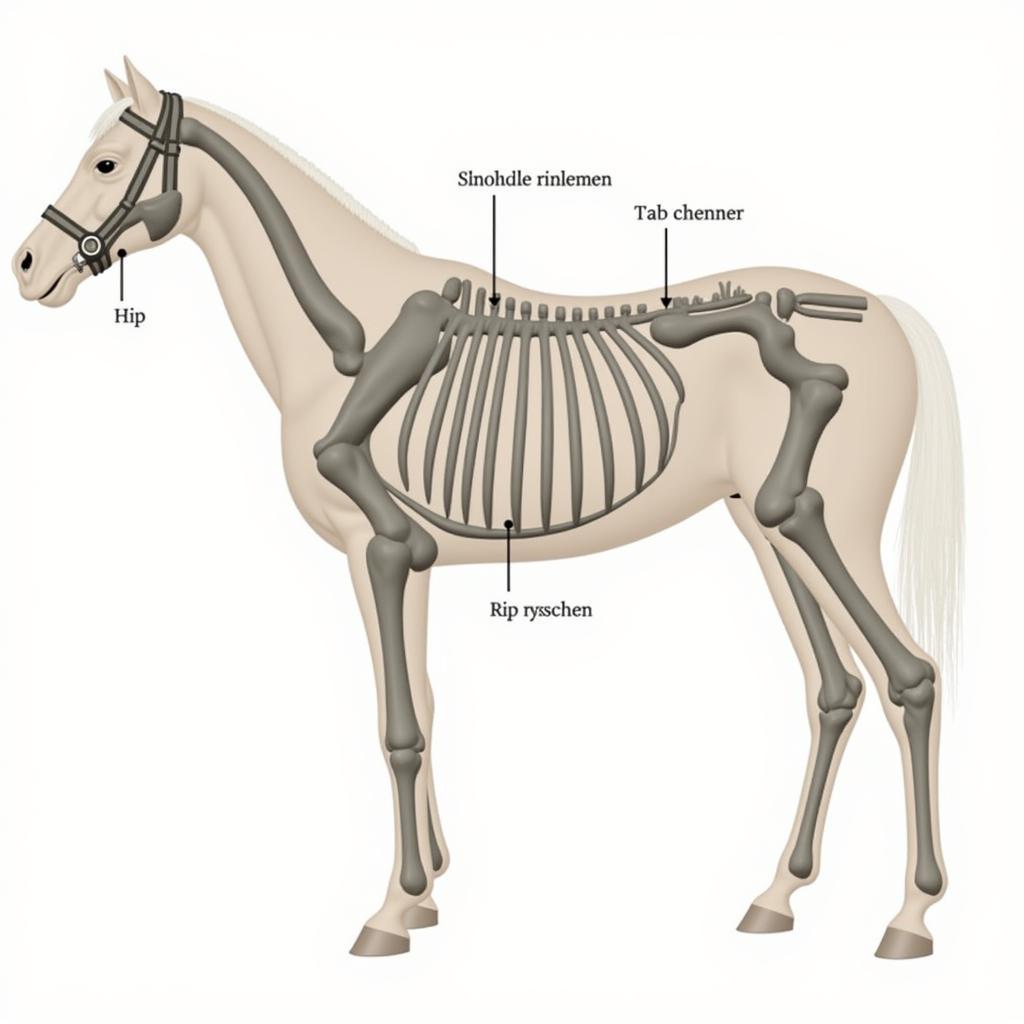The Horse Frame, encompassing the skeletal structure, musculature, and overall build, is fundamental to understanding equine performance and well-being. Whether you’re a seasoned equestrian or simply fascinated by these magnificent animals, comprehending the horse frame is crucial for effective training, proper care, and appreciating the nuances of equine movement. This comprehensive guide will delve into the intricacies of the horse frame, exploring its various aspects and their impact on a horse’s abilities.
Defining the Horse Frame: A Closer Look
The horse frame isn’t just about size; it’s about the proportion and balance of different body parts. A well-balanced frame allows for efficient movement, strength, and athleticism. We’ll explore the key elements that contribute to a strong and functional frame, including bone structure, muscle development, and the angles of various joints. These components work together harmoniously in a well-conformed horse. This understanding is essential for anyone involved with horses, from riders and trainers to breeders and owners.
 Horse Frame Anatomy
Horse Frame Anatomy
The Importance of Conformation in the Horse Frame
Conformation, the physical arrangement of bone and muscle, plays a pivotal role in a horse’s performance potential. Certain conformational traits can predispose a horse to specific disciplines. For example, a horse with a long, sloping shoulder and powerful hindquarters might excel in dressage, while a shorter, stockier build might be better suited for jumping. Understanding these relationships allows us to appreciate the diversity within equine breeds and the specialized adaptations that make them suitable for different activities.
“Conformation is the foundation upon which a horse’s athleticism is built,” says renowned equine veterinarian Dr. Emily Carter. “Identifying desirable traits is essential for selecting the right horse for a specific discipline and maximizing its potential.”
How the Horse Frame Influences Movement
The interplay between bone structure, muscle, and tendons determines how a horse moves. A well-balanced frame allows for fluid, efficient gaits, minimizing strain on joints and maximizing power output. Conversely, conformational flaws can lead to restricted movement, lameness, and reduced performance. We’ll explore how the various components of the horse frame contribute to different gaits, from the graceful walk to the explosive gallop.
Common Horse Frame Challenges and Solutions
While a “perfect” horse frame is rare, understanding common conformational flaws and their potential implications is crucial for horse owners and enthusiasts. Issues like long pasterns, upright shoulders, or a swayback can impact a horse’s soundness and performance. We’ll discuss these challenges and offer insights into management strategies, including targeted exercises, specialized shoeing, and appropriate training techniques.
“Addressing conformational challenges early on can significantly improve a horse’s long-term soundness and well-being,” explains expert horse trainer, John Miller. “Proper management can often mitigate the negative impacts of certain conformational traits.”
Evaluating the Horse Frame: What to Look For
Whether you’re purchasing a horse or simply evaluating your own horse’s conformation, knowing what to look for is essential. We’ll provide a practical guide to assessing the horse frame, outlining key observations and measurements. This knowledge will empower you to make informed decisions about horse selection, training, and management, ultimately contributing to your horse’s overall well-being.
Check out our horse frames for beautiful ways to display your equine companion. You may also be interested in horse framed art.
Conclusion: The Horse Frame – A Foundation for Success
The horse frame is a complex and fascinating subject, crucial for understanding equine performance, health, and overall well-being. By appreciating the interplay between conformation, movement, and management, we can ensure that our equine partners thrive in their chosen disciplines and enjoy long, healthy lives. Investing time in understanding the horse frame is an investment in your horse’s future. Consider browsing our selection of picture frame horse options as well.
FAQ
- What are the key components of the horse frame?
- How does conformation affect a horse’s performance?
- What are some common conformational flaws?
- How can I evaluate a horse’s frame?
- What are the different types of horse frames?
- How does the horse frame relate to gaits?
- What management strategies can address conformational challenges?
Common Situations & Questions
- Scenario: My horse has long pasterns. What should I do? Answer: Consult with a farrier and veterinarian for appropriate shoeing and exercise recommendations.
- Question: How can I tell if my horse’s frame is suitable for jumping? Answer: Look for a well-balanced frame with a sloping shoulder and powerful hindquarters. A professional evaluation can provide more specific insights.
Further Exploration
For more information, see our articles on framed horse picture and horse license plate frames.
Need assistance? Contact us at Phone: 0772127271, Email: [email protected] or visit us at QGM2+WX2, Vị Trung, Vị Thuỷ, Hậu Giang, Việt Nam. We have a 24/7 customer service team.